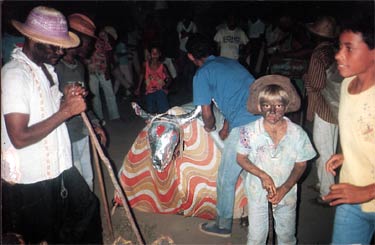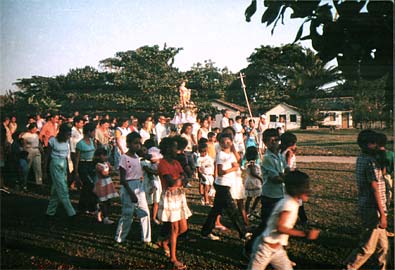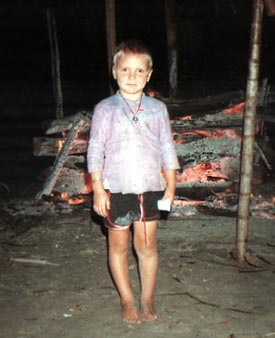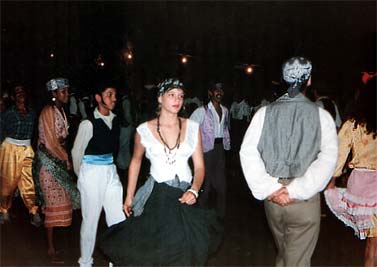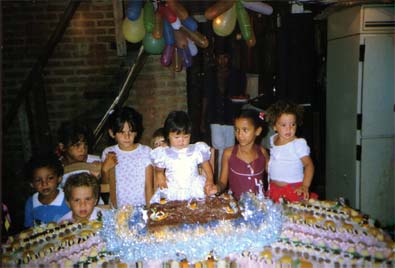| |
|
|
|
|
| |
|
|
|
| |
|
|
|
|
| |
|
Brazilians
love to party, to celebrate. Throughout the year there are a number of traditional
festas of great importance, all more or less connected to the Church
calendar and involving saints. Each of this festas has its very
own customs, its special rituals and songs. |
|
|
| |
|
Fatima
told me that many of the traditions she grew up with are changing and even
disappearing. Life in Trancoso has changed dramatically due to the influx
of people from all over Brazil, who now greatly influence the social life
of the place. They brought their own customs along and the old ways are
getting forgotten. |
|
|
| |
|
I
am grateful for the help of my daughter, who still remembers the festas
as they used to be in the eighties and helped me with this section. |
|
|
| |
|
|
|
|
| |
|
|
|
|
| |
|
Rashid
at "Bumba meu boi" |
|
|
| |
|
|
|
|
| |
|
The first
holiday of the year used to be Bumba meu boi, on the day of Epiphany
or Three King's Day. After nightfall, a man in the costume of a boi
(bull), gets driven through the village by a few black-faced guys wielding
sticks, accompanied by the dancing villagers singing the songs belonging
to this holiday. Arriving at the house of the festeiro, the man in
charge of the festivity who has to supply food and drink to the crowd,
the boi lies down and gets "slaughtered", following the
announcement of: "Vamos repartir o boi, pessoal" (let's
divide the bull, folks). Singing amusing verses about every part
of the boi and who's gonna get it, everybody has great fun.
|
|
|
| |
|
All the
while people have to look out for the jaguará, who jumps out
of dark hiding places, attacking them using a dead horse's head to savagely
bite whoever he catches. In older times, the horse's mouth used to be filled
with red hot charcoal, making the bites a lot more painful! |
|
|
| |
|
|
|
|
| |
|
|
|
|
| |
|
procession back in the eighties |
|
|
| |
|
|
|
|
| |
|
At
the end of January, the first one of the big saint's holiday, the festa
of São Sebastião, is celebrated. Those saint's
days usually follow the same pattern each: On the night before the saint's
day, the celebrations start with the vespera at the place of the
festeiro. Festeiros are usually chosen according to their
status in the village hierarchy and their ability to finance food and
drink for hundreds of people. The participants of the vespera have
to stay awake the whole night drinking and dancing; they are not allowed
any sleep. At dawn the group, its members near collapse from excessive
drinking and lack of sleep, picks up the saint's new pole and flag, which
will stand in front of the church for a whole year, until the same saint's
festa comes round again. Pole and flag are painted in the saint's
appropriate colours, but with yearly differing patterns. The new pole
gets deposited on the ground in front of the church and some of the tired
folks go home for a nap. |
|
|
| |
|
At
noon everybody gathers at the festeiro's house for rice, beans and
meat. Not to mention the great amounts of cachaça and batida
that have to be supplied by the festeiro as well. |
|
|
| |
|
|
|
|
| |
|
|
|
|
| |
|
Fatima
as a very tired little angel |
|
|
| |
|
|
|
|
| |
|
After
all bellies are filled, the procession starts, the statue of São
Sebastião gets carried around the village while the saint's
songs are sung and drums beaten. Back at the church, with little girls dressed
as angels looking on, the pole is raised and imbedded in the ground, where
it will stay for a year, until the next festival of São Sebastião.
A fellow holding two sticks dances in front of the saint, who, strangely,
gets cursed at and even beaten with those sticks. Onlookers get hit as well
if they venture too near. |
|
|
| |
|
|
|
|
| |
|
In the
evening there's forró, traditional dancing and merrymaking,
but attendance can be low, because many of those participants that were
up since vespera the day before have no strength left for yet another
night of partying. |
|
|
| |
|
|
|
|
| |
|
|
|
|
| |
|
About
a week later, the festa of São Braz is celebrated. The festivities
are about the same as for São Sebastião, just the
songs and the colours of the pole and the flags differ. Fatima attended
São Braz in 2002 and took some pictures (click to enlarge)
: |
|
|
| |
|
|
|
|
| |
|
|
|
|
| |
|
|
|
|
| |
|
|
|
|
| |
|
On Páscoa
(Easter), the village youths visit the old folks, kneeling at their doors
to get a blessings and some cake. Fatima, who went along for the sweets,
told me that some mean old people used to scatter grains of corn and sand
at the thresholds to keep the youngsters off. |
|
|
| |
|
|
|
|
| |
|
The biggest
event of the year is the festa of São João.
It's actually Midsummer Night, the Summer Solstice, only in Brazil it's
in the middle of Winter. |
|
|
| |
|
Starting
on June 22th the festivities last a whole week. The actual day of ,
the village's patron saint, is the 24th., the following days belonging each
to a different saint. It's a whole week of processions, dancing, revelry.
Drinking and eating is supplied at the houses of the respective festeiros.
Fogueiras (bonfires) are lit in front of homes, people gather around
the flames, telling stories and plying their instruments until the first
light of dawn. Housewives sell quentão, a delicious hot
drink made of ginger root, fruit juice and cachaça, that
warms both body and soul. |
|
|
| |
|
|
|
|
| |
|
|
|
|
| |
|
Rashid
at São João in his first year in Brazil |
|
|
| |
|
|
|
|
| |
|
The
24th of June used to be long awaited by the village youths, who'd spent
a whole months with rehearsals for the dance of the quadrilha. Wearing
straw hats or scarves, the girls dressed in frilly dresses and the boys
in long trousers and shirts, the adolescents gather on the village square,
forming two queues, one for each gender, and the quadrilha starts.
|
|
|
| |
|
Dancing
to the commands of the leader located in the middle of the formation,
the lines of dancers form a circle, the circle dissolves into other patterns,
couples join hands, turn round, change partners. Each step and movement
follows the calls of the leader. On his call: "Olha chuva" (mind
the rain) hands are raised protectively above heads, hearing "Olha
pai da moça" (mind the girl's father) the couples stop touching,
"Olha cobra" (mind the snake) has the dancers jump over an imaginary
serpent. |
|
|
| |
|
Towards
the end of the dance, a fake priest enacts a fake "casamento"
(marriage) , in the course of which the bride gets abducted by a robber.
The quadrilha ends amidst great shouting and screaming. |
|
|
| |
|
|
|
|
| |
|
|
|
|
| |
|
Fatima
dancing the "quadrilha" of São João, around 1992 |
|
|
| |
|
|
|
|
| |
|
Customarily,
for each day of a festa people, and children especially, needed
a new outfit. It took my kids a while to convince me of the importance of
buying new clothes despite there actually was no need for any. We had brought
many beautiful clothes from Asia, made of Indian silks and Chinese brocades,
and I'd have thought Fatima could wear those for special occasions. No way,
it had to be something new every time, it needn't be anything festive or
expensive, just new. That was the way kids in Trancoso got their clothes,
after the holiday the new outfits would be worn for school, play and work,
and until the net festa often were reduced to mere tatters. |
|
|
| |
|
My
friend and neighbor Zilda turned out to be a gifted tailor, happy to earn
a few coins, so I usually asked her to sew the clothes for my kids. She
made my dresses as well, from living in the East I was used to having my
clothes made according to my own taste and style. |
|
|
| |
|
|
|
|
| |
|
Christmas,
the biggest holiday in most Christian countries, isn't very remarkable in
Trancoso. Though with ever more foreigners living there, this might be changing
as well. |
|
|
| |
|
|
|
|
| |
|
Children's
birthdays were commemorated with much enthusiasm and huge, lovingly decorated
cakes. For my taste they were far too sweet, and often the main ingredients
were just flour and water, with some chocolate added. Anyhow, to the unspoiled
taste buds of the local kids those cakes sure tasted great. They had to
be cut into a great amount of small chunks, to allow all the youngsters
gathered around to make off happily with a tiny piece wrapped in a paper
napkin. Some kids suppressed the urge to devour their handfull of bliss,
and brought it home to share with their family. |
|
|
| |
|
Birthday presents
mostly were rather basic as well: A cake of soap, a tube of toothpaste,
or a pack of cookies. |
|
|
| |
|
|
|
|
| |
|
|
|
|
| |
|
a typical birthday party |
|
|
| |
|
|
|
|
| |
|
One thing
about those birthday parties I didn't like at all: Children often drank
alcohol. Nobody seemed to mind, it was the grownups themselves who gave
them cheap wine or home made batida to drink. As much as I told my own kids
to stay away from those beverages, Rashid more than once returned from a
friend's birthday with that telling gleam in his eyes. |
|
|
| |
|
What really
got me mad though was an incident on the occasion of Radhid's own birthday
at our place. I had bought some wine for the adults, and made it very clear
that none of it was to be given to any kids, they were have the the soft drinks.
Suddenly I saw my youngest, one year old Ahmed, teetering and, not being
able to keep standing, falling to the ground. I tried to help him stand
up again, in vain, he collapsed and started to cry. Something was fishy.
Ahmed seemed to be near to fainting and really ill. I showed him to a neighbor,
who took a good look and declared him as drunk!. I nearly went berserk. My neighbor
tried to calm me down, telling me that her own little boy, of the same age
as mine, had been drunk once as well. |
|
|
| |
|
Now that
didn't help me at all, I was fearing for the life of my baby. The only thing
we could do was massaging Ahmed's feet and putting him to sleep. Next day
he was OK again. It transpired later that a young neighbor woman had given
the little boy a whole cup of wine to drink. |
|
|
| |
|
|
|
|
| |
|
At night there often were parties in bars, on
the beach or at somebody's house. I never attended any of those, knowing
very well I wouldn't like it. Dancing to loud disco music had ceased to
interest me when I was sixteen and started to travel, my alcohol habit amounted
to hardly more then a cold beer once in a while after shopping in the dusty heat of Porto
Seguro, and I detest cocaine. |
|
|
| |
|
Even without any party, the bars bordering the village square
came alive in the evening, and all night long music was played at full power.
In summer season, bars and restaurants were crowded, tourists mixing with
locals to drink and dance. Off season, one might walk into one of those
tiny bars at three in the morning, drawn by the intensity of the blaring
sound emanating from its open door, to find nobody inside but the youthfull
owner sitting half asleep behind his counter. |
|
|
| |
|
|
|
|
| |
|
I seldom left our property if it wasn't to buy groceries for the restaurant or something else we needed. When Grande, our first mason, who'd stopped working
for us after a year to open a bakery, invited me to his birthday party I
accepted though. A party attended mainly by locals, without tourists or
rich dropouts from Brazil's south, was more to my liking. The natives back
then weren't into cocaine yet, though, alas, this was going to change soon. |
|
|
| |
|
So I got myself ready in the late afternoon and
left home to walk the few hundred meters to Grande's home. On crossing the
quadrado, a totally upset Fatima caught up with me, got hold of
my arm and cried: "No, Mama, you can't go." I don't know for sure
why she tried to stop me, I suspect she was shocked because it was so very
unusual for me to leave the house to go to a party. |
|
|
| |
|
|
|
|
| |
|
Mother's
Day is duly celebrated in Trancoso as well. On one such Mother's day, we
mothers were called to the village school to watch our kids reciting poems
about, guess what, mothers. It was real sweet. |
|
|
| |
|
On my
first Mother's Day in Brazil, some women and youths were enacting "living
pictures" at the village church. An improvised curtain went up and
down, each time exposing a group dressed in costumes and arranged in a diferent
manner symbolizing something related with motherhood. Though why they chose
a young blonde with not yet any offspring of her own for the part of the
mother will forever remain a mystery to me. If anything was abundant in
Trancoso, it was real mothers of any type, even a few who had given birth
up to twenty (!) times. |
|
|
| |
|
|
|
|
| |
|
Brazilians
love their children abundantly, and Children's Day is an important holiday, where the kids get spoiled and receive a few presents. |
|
|
| |
|
|
|
|
| |
|
|
|
|
| |
|
|
|
|
| |
|
|
|
|
| |
|
|
 |
|

